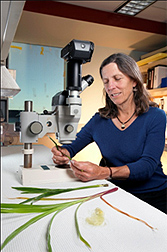 Scientists at the USDA might have found a way to keep switchgrass forever young and better for cellulosic ethanol. Agricultural Research Service (ARS) geneticist Sarah Hake, working with University of California-Berkeley plant geneticist George Chuck, found that taking a gene from corn called corngrass and inserting it into switchgrass keeps the grass always in a juvenile form that doesn’t flower, doesn’t produce seeds, and doesn’t have a dormant growth phase. And that means the sugars in the plant starch are more readily available for conversion into cellulosic ethanol.
Scientists at the USDA might have found a way to keep switchgrass forever young and better for cellulosic ethanol. Agricultural Research Service (ARS) geneticist Sarah Hake, working with University of California-Berkeley plant geneticist George Chuck, found that taking a gene from corn called corngrass and inserting it into switchgrass keeps the grass always in a juvenile form that doesn’t flower, doesn’t produce seeds, and doesn’t have a dormant growth phase. And that means the sugars in the plant starch are more readily available for conversion into cellulosic ethanol.
The scientists observed that the leaves in the transgenic switchgrass are not nearly as stiff as leaves in switchgrass cultivars that haven’t been modified. In addition, they determined that leaf lignin is slightly different in the transgenic switchgrass than leaf lignin in other plants. This could lead to new findings on how to break down the sturdy lignin and release sugars for fermentation, a development that will be essential to the commercial production of cellulosic ethanol.
The researchers are now introducing DNA segments called genetic promoters that would “turn on” the expression of the corngrass gene just in aboveground switchgrass shoots. This could help increase root mass development that otherwise would be inhibited by the gene. Hake and Chuck also suggest that developing nonflowering switchgrass varieties would eliminate the possibility of cross-pollination between transgenic switchgrass cultivars and other switchgrass cultivars.
The work was published in 2011 in Proceedings of the National Academy of Sciences.

